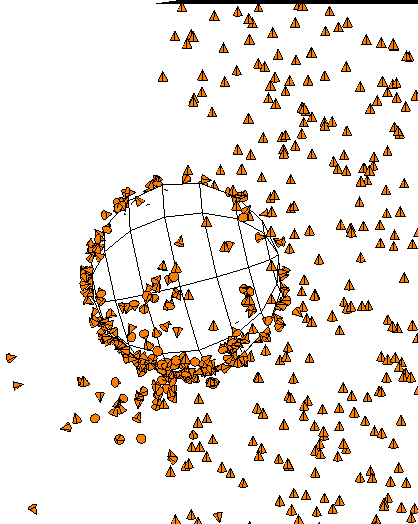Using the Slide on Surface compound, you can make particles cling to and slide on an obstacle's surface. Obstacles can be deform-animated and the particles will follow the shape of the changing surface. You also have several controls to help create the correct conditions in which the particles will drip off the obstacle. This is useful for creating sweat, water condensation, or other liquid drops sliding down a surface and then dripping off.
You can choose to use the Slide on Surface compound on its own or as part of a more extensive effect via a State system.

Particles sliding along several obstacles' surfaces.
Making Particles Slide on an Obstacle
To make particles slide on and drip off of an obstacle
Create one or more objects that you want to use as surfaces for the particles to slide upon. These objects need to have geometric surfaces, such as polygon meshes or NURBS surface objects. Make sure that the particles will reach these obstacles at some point in the simulation.
Create a particle emission — see Creating a Basic Particle Emission.
Choose Particles  Collision
Collision  Slide on Surface from the ICE toolbar.
Slide on Surface from the ICE toolbar.
This command adds the Slide on Surface compound to the ICE tree, plugging it into the Execute port of the Simulation Root compound.
Pick one or more objects to use as the surfaces for sliding. Each object's Get data node is then plugged into the Surface port of the Slide on Surface compound.
You can also add more obstacles objects to the ICE tree later — drag each object's name into the ICE Tree view to create a Get Data node for it, then plug it as the other obstacles.
In the Slide on Surface property editor, set the Slide parameters, which determine how the particles slide off the obstacle.
To make particles drip, see Making Particles Drip Off the Obstacle.

To use the Slide on Surface compound with a state system
Create a particle emission — see Setting Up Any Type of ICE Particle Emission for information.
In the ICE Tree, set up a State Machine and State compounds as you like, as described in Overview of Creating a Particle State Setup.
Plug the Slide on Surface compound's Execute output into an Execute Every Frame port of a State compound.
Continue with creating the effect you want with the State compound.
Making Particles Drip Off the Obstacle
Once particles are sliding on an obstacle object, you can set up the special conditions upon which the particles will drip off the obstacle. The conditions are based on:
As well, you can have some event happen when the particles drip off the obstacle object, such as the particles changing color or size.
To make particles drip off of an obstacle
Set up the particles to slide on an obstacle as described in Making Particles Slide on an Obstacle.
Open the Slide on Surface property editor and set the Drip parameters.

Particles slide down the sphere (obstacle) as it passes through a field of falling particles. They only drip off the sphere when the force and angle threshold values are reached, and enough particles have accumulated within a certain range.